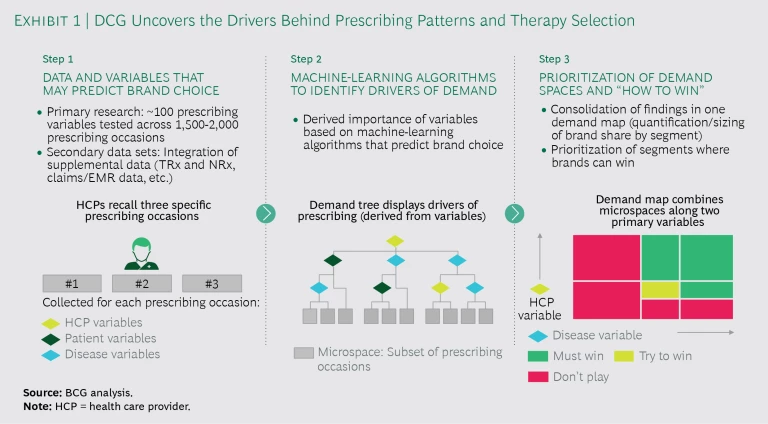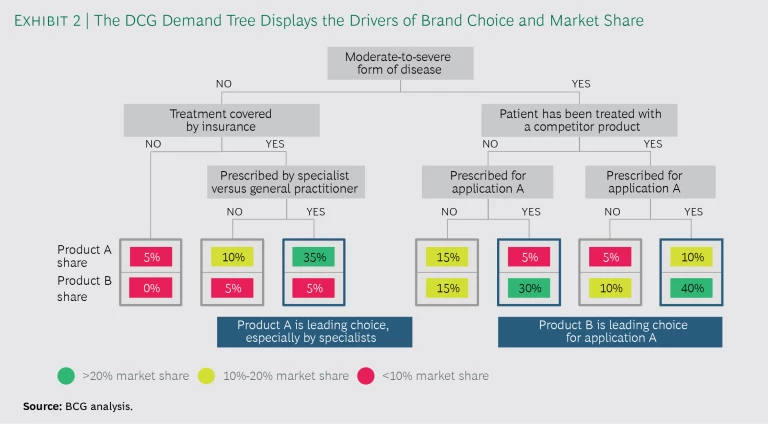In an increasingly dynamic environment, pharma brand teams frequently struggle to gain a full understanding of the factors that drive their products’ sales. They have difficulty identifying the reasons behind physician and patient decision making when it comes time to choose a particular treatment. Traditional market research and data have not been much help. Studies conflict or fail to provide a single—or reliable—source of truth. The complaints we hear most often from our pharma clients are “We generate tons of data but no actionable insights,” and “We are using the same tools and methodologies that we used ten years ago.”
Help is here. A proprietary research and marketing strategy developed by BCG, known as Demand Centric Growth (DCG), enables companies to view the demand for their products through a new lens, guided by data and powered by machine learning. DCG provides fresh insight by identifying and quantifying the circumstances surrounding the prescription of treatments. By taking into account the ways in which a multitude of factors converge at the moment of the prescribing decision, DCG helps pinpoint the distinct situations in which a company’s treatments are the most relevant and could have the greatest impact on prescribing. This quantitative, scalable, and automated approach to analyzing qualitative health care provider (HCP), caregiver, and patient interviews integrates other quantitative data sources (whether company owned or provided by a third party) and seeks to help companies better understand prescribing behaviors and uncover actionable patterns in these behaviors.
Understanding the Drivers of Demand
Take the case of a pharma manufacturer that markets multiple treatments for a common dermatological condition. Sales of two of its longtime products had fallen 15% and 20%, respectively, year over year. Meanwhile, sales of a newly launched product were not growing fast enough to compensate; overall demand for its dermatological treatments had dropped 10% in one year. The company’s marketing and sales teams were at a loss to dissect exactly what was going on and lacked the critical insights to act decisively. They could not agree on how to allocate scarce sales and marketing resources among the products, how to promote each product, and which messages and tactics to double down on and why. Extensive primary and secondary market research delivered a host of conflicting results but no answers about where to find a source of new growth.
DCG research—combined with machine-learning algorithms—not only revealed what was happening at the point of decision making in the doctor’s office but also predicted in a quantifiable manner the situations in which each product could gain greater market share. For example, the company’s new product was highly sensitive to sales promotion—multiple visits by sales reps drove a high level of prescribing—but the company was not making enough sales calls. DCG also revealed that the new product was prescribed for specific applications with distinct treatment goals. The research showed that the legacy product was still popular with doctors and patients for different treatment goals, such as when the treatment area was localized to certain parts of the body.
The overall study enabled the company to segment and size the market according to the drivers of demand for its products. On the basis of this new insight, it decided to embark on a bold strategy. All sales resources were redirected to support the new product, and all promotional materials were revised with stronger messaging to emphasize specific use cases. At the same time, the company put a digital strategy in place (without including any sales calls) to protect the sales volume of its legacy portfolio. Year-over-year results speak for themselves: sales of the new product have registered double-digit increases while the legacy portfolio has maintained (and even slightly boosted) its market share. Overall portfolio growth is in the high single digits—a total turnaround.
As we’ll see later, this company’s experience was far from unique—when pharma companies learn more about what drives the demand for their treatments, they can use that knowledge to generate or reinvigorate the growth of their products. DCG is a high-impact marketing strategy for pharma manufacturers. Doctors and patients also benefit because better information from the manufacturers can help doctors prescribe the most relevant and appropriate treatment option for their patients for each specific disease circumstance and prescribing situation.
How DCG Works
Developed initially for consumer goods companies, DCG has proved highly accurate at assessing and predicting demand in multiple industries, among them, travel, hospitality, retail, and financial services. DCG is a two-stage process. The first stage uncovers the principal drivers of demand and determines how to act on them; the second sets a strategy and a plan of execution (across functions) for the organization to follow.
Mapping Demand. The first stage involves an integrated, quantitative approach to qualitative market research with HCPs, caregivers, and patients; this type of research takes into consideration the fact that individuals typically have different needs (and thus make different decisions) depending on the treatment category, circumstances, and context. (See Exhibit 1.) A DCG survey asks HCPs to think clinically about their therapy choices by revisiting two or three of their most recent prescribing occasions. We ask HCPs to recall the specific circumstances for each occasion, including the demographic and clinical characteristics of the patient and the reasons behind the choice of therapy. We gather a robust database of 50 or more variables related to the physician, patient, and disease from as many as 1,000 to 5,000 prescribing occasions. These variables can include the HCP’s specialty, practice, and number of patients as well as each patient’s gender, age, insurance coverage, and treatment history for the condition. We combine these data sets with records of other relevant data and events, such as field force call activity, online engagement, prescribing data, and information from matched data sources (such as anonymized claims records and electronic medical and health records).
Machine-learning algorithms then derive the importance of each variable and generate a “demand tree” of prescribing behavior for a specific condition that highlights the factors that are the strongest predictors of choice. (See Exhibit 2.) We then match the demand tree with a comprehensive market picture, or “demand map,” that captures the entire market for a particular treatment, including the market’s size and composition, the treatment’s competitive set, and the messaging that—given the analysis of the variables shaping demand—will resonate most strongly with different HCP and patient segments. Brand teams can use these insights to develop algorithms that identify high-potential patient and physician segments in broader linked data sets (such as claims, electronic medical and health records, real-world evidence data, and specialty pharma data).
From Analysis to Action. Using the demand map, pharma companies can set a growth strategy for the brand or product in question and then design and execute an integrated plan of action that involves product modification, communication, sales, and postsales follow-up. (See Exhibit 2.)
DCG provides a comprehensive approach that addresses critical elements of the commercialization and sales process:
- Messaging and positioning—refreshing or revising brand strategy and sales materials
- Algorithms to find and target the right physicians and patients
- Field force deployment and effectiveness—redeploying sales personnel as needed for more targeted and more frequent outreach
- Digital marketing and omnichannel capabilities—taking advantage of digital and direct-to-consumer channels, including opportunities for personalized outreach
- Medical affairs and education—aligning key opinion leader and medical-education strategies with HCP needs
- Managing market access and payer contracting—directing communications and negotiations with payers
- Managing patient affordability and patient access programs
Putting DCG to Work in Pharma
Here’s how it worked for another pharma company. We asked approximately 400 HCPs for the details of three recent prescribing occasions, from which we mined 1,200 individual prescribing occasions and 500,000 data points, from both DCG research and matched data sets. Because of an increasingly competitive environment, the company’s gastrointestinal brand was experiencing slower than expected growth. Attitudinal market research had been inconclusive and failed to highlight a specific explanation for what had changed and why. It also lacked quantification of subsegments. The DCG analysis enabled segmentation of the 1,200 prescribing occasions as an approximation for the overall market. According to the analysis, HCPs (including PCPs as well as gastrointestinal and pain specialists) had started to relegate the company’s brand to patients with less severe symptoms, and disease severity levels had a large influence on drug choice. Based on this insight, the company revised its marketing messaging and moved from talking about the product’s mechanism of action and convenience to touting its efficacy and speed of onset. This also led to significant changes in the company’s physician targeting for both personal and nonpersonal promotion.
In yet another example, a pharma company’s musculoskeletal treatment was struggling with low and stagnating share against a generics competitor. The manufacturer had built its strategy around promoting its drug’s efficacy in patients who were also experiencing a fairly common comorbidity. DCG research dispelled the misconception that the simple presence of the particular comorbidity drove prescribing. Instead, DCG findings suggested that the severity of the comorbidity is the true demand generator, even revealing that a new strategy focusing on specific severity levels could lead to a two- to threefold increase in market share for each of those levels. The DCG demand map gave the company the confidence to alter its strategy and reposition the brand in a smaller but more promising segment of the market. By focusing promotional efforts on this new segment, the company saw a 10% jump in new-to-brand prescriptions for its product in just the first week after the rollout of new sales materials and messaging.
In pharma, as in other industries, poor or inadequate data has often led to less-than-effective marketing campaigns. This is changing with the explosion of data, but analysis needs to be rooted in sound methodologies that generate actionable insights. DCG gives manufacturers the data, insights, and platform they need to target their treatments. Using DCG, they can develop the integrated actions that have the biggest impact for patients and generate the highest return for brands.








